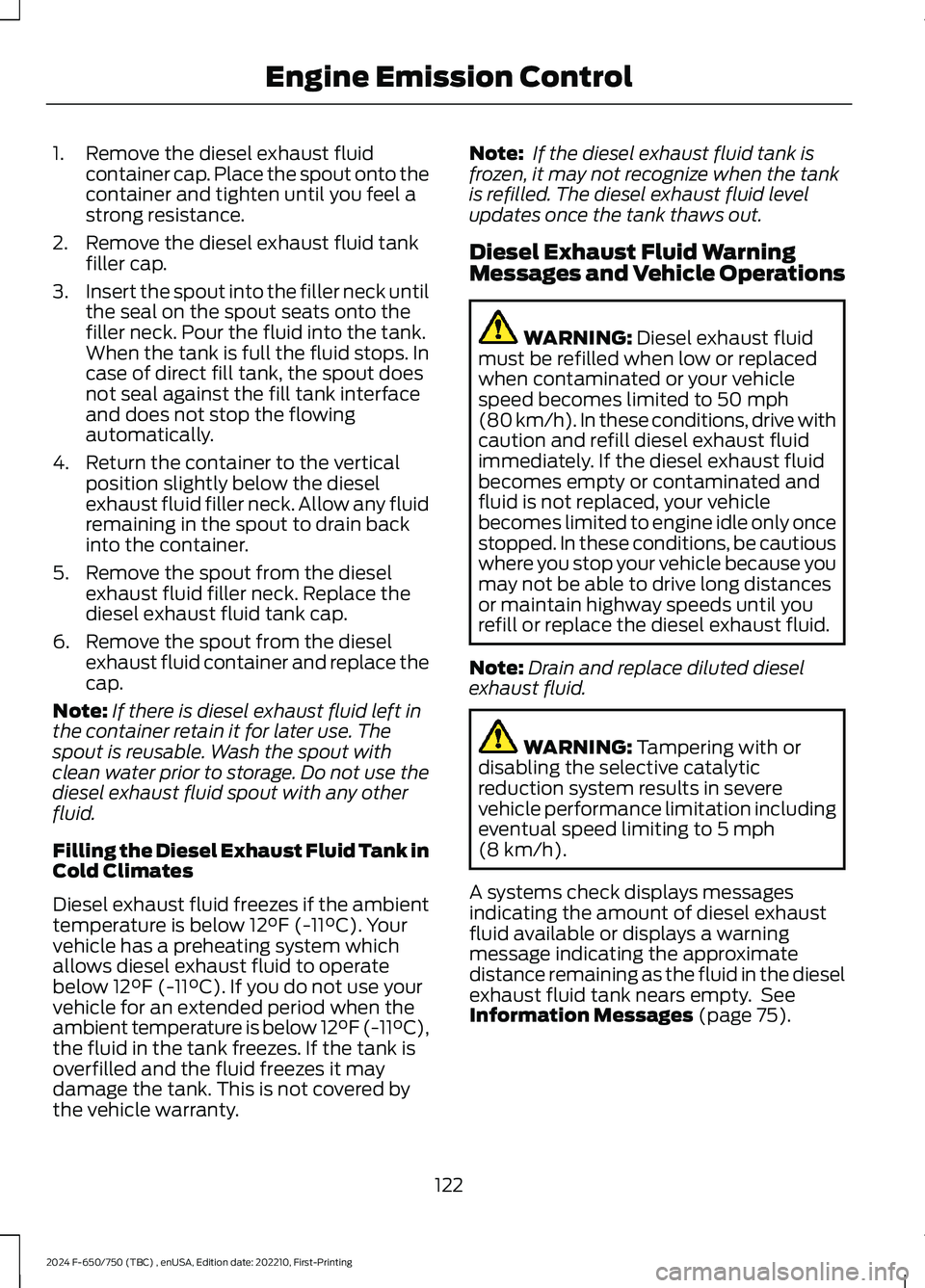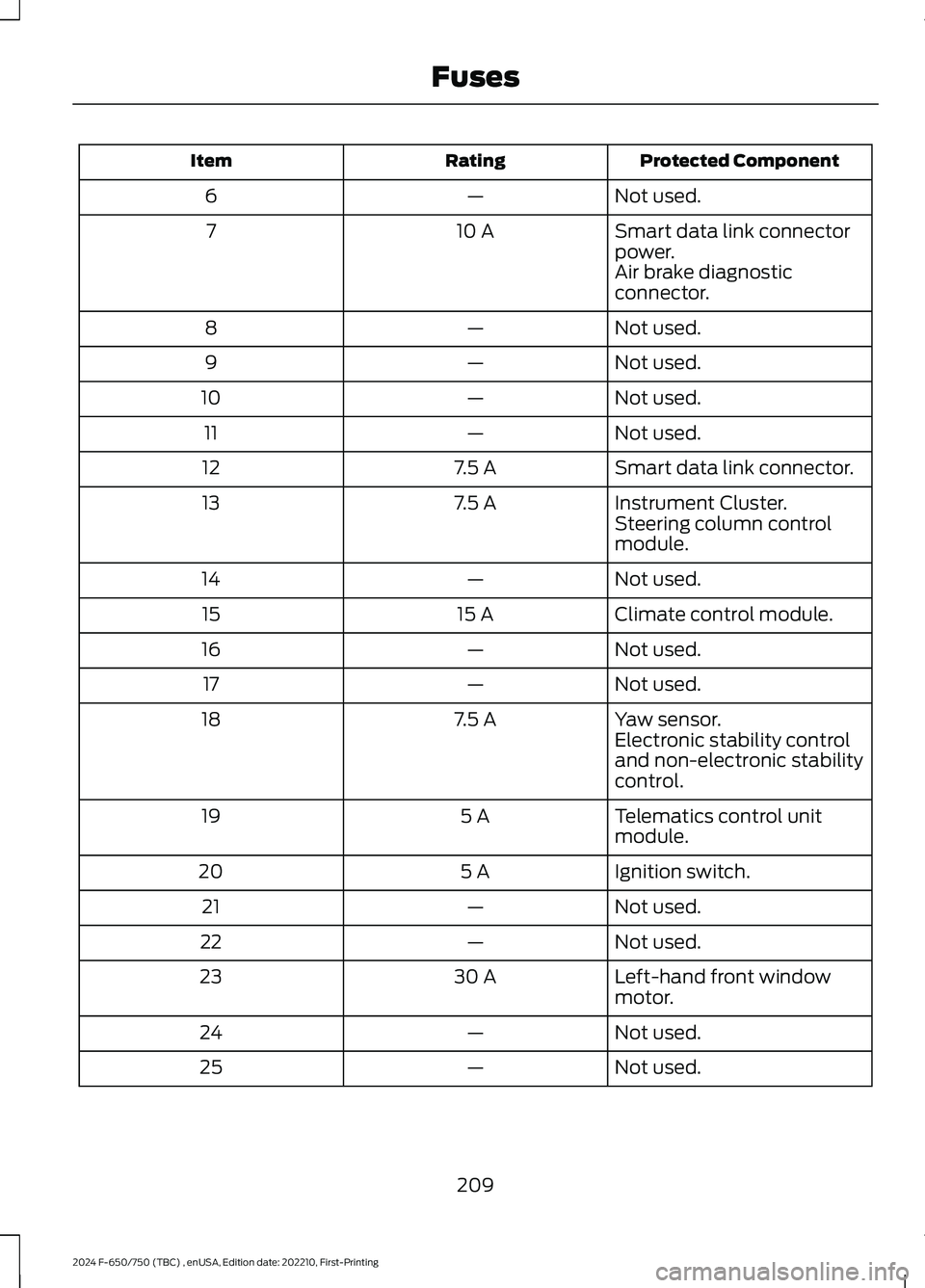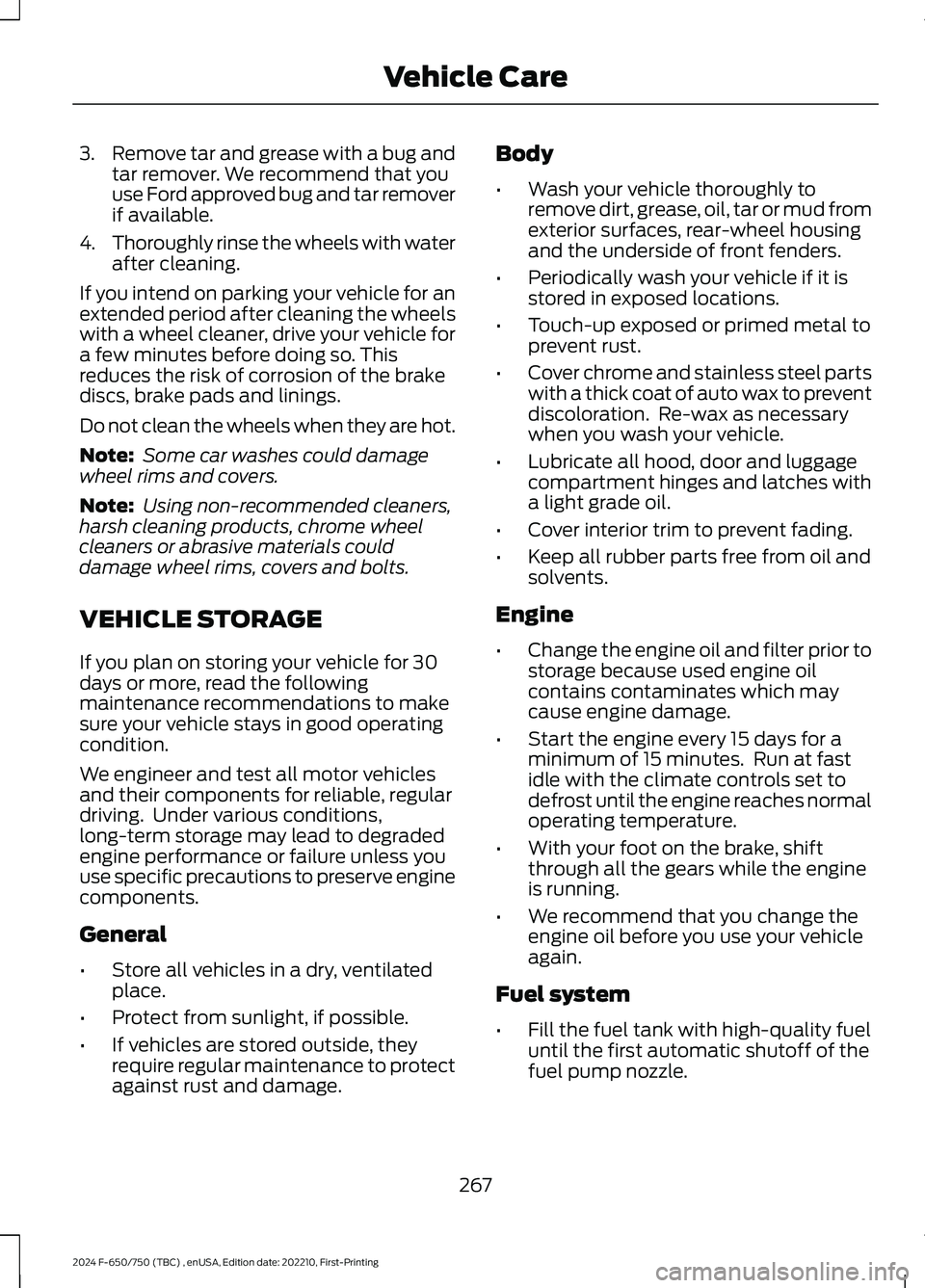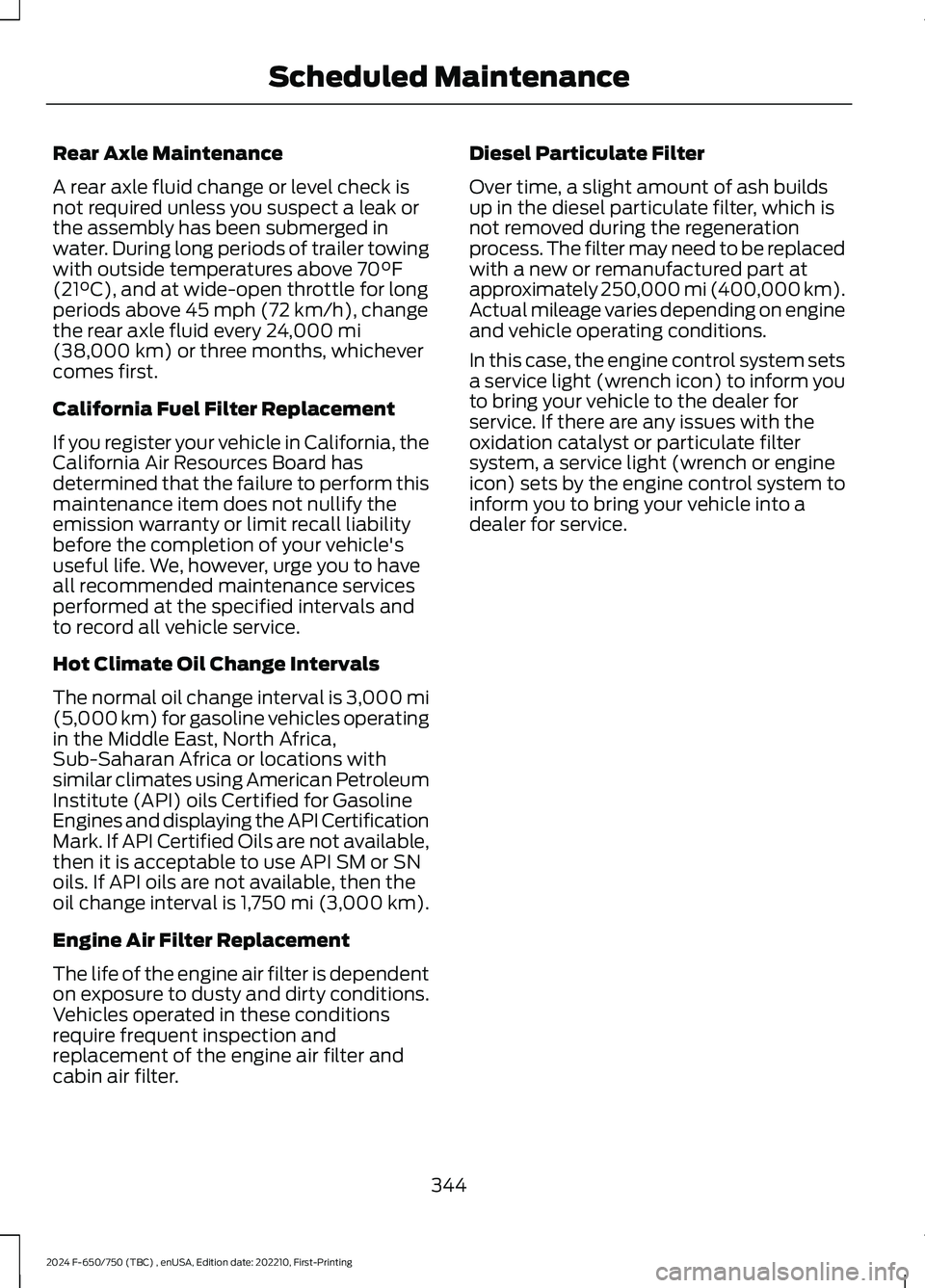2024 FORD F650/750 climate control
[x] Cancel search: climate controlPage 126 of 386

1.Remove the diesel exhaust fluidcontainer cap. Place the spout onto thecontainer and tighten until you feel astrong resistance.
2.Remove the diesel exhaust fluid tankfiller cap.
3.Insert the spout into the filler neck untilthe seal on the spout seats onto thefiller neck. Pour the fluid into the tank.When the tank is full the fluid stops. Incase of direct fill tank, the spout doesnot seal against the fill tank interfaceand does not stop the flowingautomatically.
4.Return the container to the verticalposition slightly below the dieselexhaust fluid filler neck. Allow any fluidremaining in the spout to drain backinto the container.
5.Remove the spout from the dieselexhaust fluid filler neck. Replace thediesel exhaust fluid tank cap.
6.Remove the spout from the dieselexhaust fluid container and replace thecap.
Note:If there is diesel exhaust fluid left inthe container retain it for later use. Thespout is reusable. Wash the spout withclean water prior to storage. Do not use thediesel exhaust fluid spout with any otherfluid.
Filling the Diesel Exhaust Fluid Tank inCold Climates
Diesel exhaust fluid freezes if the ambienttemperature is below 12°F (-11°C). Yourvehicle has a preheating system whichallows diesel exhaust fluid to operatebelow 12°F (-11°C). If you do not use yourvehicle for an extended period when theambient temperature is below 12°F (-11°C),the fluid in the tank freezes. If the tank isoverfilled and the fluid freezes it maydamage the tank. This is not covered bythe vehicle warranty.
Note: If the diesel exhaust fluid tank isfrozen, it may not recognize when the tankis refilled. The diesel exhaust fluid levelupdates once the tank thaws out.
Diesel Exhaust Fluid WarningMessages and Vehicle Operations
WARNING: Diesel exhaust fluidmust be refilled when low or replacedwhen contaminated or your vehiclespeed becomes limited to 50 mph(80 km/h). In these conditions, drive withcaution and refill diesel exhaust fluidimmediately. If the diesel exhaust fluidbecomes empty or contaminated andfluid is not replaced, your vehiclebecomes limited to engine idle only oncestopped. In these conditions, be cautiouswhere you stop your vehicle because youmay not be able to drive long distancesor maintain highway speeds until yourefill or replace the diesel exhaust fluid.
Note:Drain and replace diluted dieselexhaust fluid.
WARNING: Tampering with ordisabling the selective catalyticreduction system results in severevehicle performance limitation includingeventual speed limiting to 5 mph(8 km/h).
A systems check displays messagesindicating the amount of diesel exhaustfluid available or displays a warningmessage indicating the approximatedistance remaining as the fluid in the dieselexhaust fluid tank nears empty. SeeInformation Messages (page 75).
122
2024 F-650/750 (TBC) , enUSA, Edition date: 202210, First-PrintingEngine Emission Control
Page 213 of 386

Protected ComponentRatingItem
Not used.—6
Smart data link connectorpower.10 A7
Air brake diagnosticconnector.
Not used.—8
Not used.—9
Not used.—10
Not used.—11
Smart data link connector.7.5 A12
Instrument Cluster.7.5 A13Steering column controlmodule.
Not used.—14
Climate control module.15 A15
Not used.—16
Not used.—17
Yaw sensor.7.5 A18Electronic stability controland non-electronic stabilitycontrol.
Telematics control unitmodule.5 A19
Ignition switch.5 A20
Not used.—21
Not used.—22
Left-hand front windowmotor.30 A23
Not used.—24
Not used.—25
209
2024 F-650/750 (TBC) , enUSA, Edition date: 202210, First-PrintingFuses
Page 251 of 386

Note:Battery posts, terminals and relatedaccessories contain lead and leadcompounds. Wash hands after handling.
Note:Electrical or electronic accessoriesor components added to the vehicle by thedealer or the owner may adversely affectbattery performance and durability.
Your vehicle is equipped with a Motorcraftmaintenance-free battery which normallydoes not require additional water duringits life of service.
For longer, trouble-free operation, keep thetop of the battery clean and dry. Also,make certain the battery cables are alwaystightly fastened to the battery terminals.
If you see any corrosion on the battery orterminals, remove the cables from theterminals and clean with a wire brush. Youcan neutralize the acid with a solution ofbaking soda and water.
It is recommended that the negativebattery cable terminal be disconnectedfrom the battery if you plan to store yourvehicle for an extended period of time.
Because your vehicle’s engine iselectronically controlled by a computer,some control conditions are maintainedby power from the battery. When thebattery is disconnected or a new batteryis installed, the engine must relearn its idleand fuel trim strategy for optimumdriveability and performance. To begin thisprocess
1.With the vehicle at a complete stop,set the parking brake.
2.Put the gearshift in park (P) or neutral(N) and turn off all accessories.
3.Start the engine. Run the engine untilit reaches normal operatingtemperature.
4.Allow the engine to idle for at least oneminute.
5.Turn the air conditioning (if equipped)on and allow the engine to idle for atleast one minute.
6.Release the parking brake. With yourfoot on the brake pedal and with theair conditioning on, put the vehicle indrive (D) and allow the engine to idlefor at least one minute.
•If you do not allow the engine torelearn its idle trim, the idle qualityof your vehicle may be adverselyaffected until the idle trim iseventually relearned.
7.Drive the vehicle to complete therelearning process
•The vehicle may need to be driven10 mi (16 km) or more to relearn theidle and fuel trim strategy alongwith the ethanol content for flexiblefuel vehicles.
If the battery has been disconnected or anew battery has been installed, the clockand radio settings must be reset once thebattery is reconnected.
Always dispose of automotivebatteries in a responsible manner.Follow your local authorized standardsfor disposal. Call your local authorizedrecycling center to find out more aboutrecycling automotive batteries.
Battery Management System (IfEquipped)
The battery management system (BMS)monitors battery conditions and takesactions to extend battery life. If excessivebattery drain is detected, the system maytemporarily disable certain electricalfeatures to protect the battery. Thoseelectrical accessories affected include therear defrost, heated/cooled seats, climatecontrol fan, heated steering wheel, audioand navigation system. A message may beshown in the information displays to alert
247
2024 F-650/750 (TBC) , enUSA, Edition date: 202210, First-PrintingMaintenance
Page 271 of 386

3.Remove tar and grease with a bug andtar remover. We recommend that youuse Ford approved bug and tar removerif available.
4.Thoroughly rinse the wheels with waterafter cleaning.
If you intend on parking your vehicle for anextended period after cleaning the wheelswith a wheel cleaner, drive your vehicle fora few minutes before doing so. Thisreduces the risk of corrosion of the brakediscs, brake pads and linings.
Do not clean the wheels when they are hot.
Note: Some car washes could damagewheel rims and covers.
Note: Using non-recommended cleaners,harsh cleaning products, chrome wheelcleaners or abrasive materials coulddamage wheel rims, covers and bolts.
VEHICLE STORAGE
If you plan on storing your vehicle for 30days or more, read the followingmaintenance recommendations to makesure your vehicle stays in good operatingcondition.
We engineer and test all motor vehiclesand their components for reliable, regulardriving. Under various conditions,long-term storage may lead to degradedengine performance or failure unless youuse specific precautions to preserve enginecomponents.
General
•Store all vehicles in a dry, ventilatedplace.
•Protect from sunlight, if possible.
•If vehicles are stored outside, theyrequire regular maintenance to protectagainst rust and damage.
Body
•Wash your vehicle thoroughly toremove dirt, grease, oil, tar or mud fromexterior surfaces, rear-wheel housingand the underside of front fenders.
•Periodically wash your vehicle if it isstored in exposed locations.
•Touch-up exposed or primed metal toprevent rust.
•Cover chrome and stainless steel partswith a thick coat of auto wax to preventdiscoloration. Re-wax as necessarywhen you wash your vehicle.
•Lubricate all hood, door and luggagecompartment hinges and latches witha light grade oil.
•Cover interior trim to prevent fading.
•Keep all rubber parts free from oil andsolvents.
Engine
•Change the engine oil and filter prior tostorage because used engine oilcontains contaminates which maycause engine damage.
•Start the engine every 15 days for aminimum of 15 minutes. Run at fastidle with the climate controls set todefrost until the engine reaches normaloperating temperature.
•With your foot on the brake, shiftthrough all the gears while the engineis running.
•We recommend that you change theengine oil before you use your vehicleagain.
Fuel system
•Fill the fuel tank with high-quality fueluntil the first automatic shutoff of thefuel pump nozzle.
267
2024 F-650/750 (TBC) , enUSA, Edition date: 202210, First-PrintingVehicle Care
Page 291 of 386

Sometimes irregular tire wear canbe corrected by rotating the tires.
USING SNOW CHAINS
WARNING: Wheels and tires mustbe the same size, load index and speedrating as those originally fitted on thevehicle. Use of any other tire or wheelcan affect the safety and performanceof your vehicle. Additionally, the use ofnon-recommended tires and wheels cancause steering, suspension, axle, transfercase or power transfer unit failure.Follow the recommended tire inflationpressures found on the SafetyCompliance Certification label, or theTire Label on the B-Pillar or the edge ofthe driver door. Failure to follow thisinstruction could result in loss of vehiclecontrol, vehicle rollover, or personal injuryor death.
The tires on your vehicle have all-weathertreads to provide traction in rain and snow.However, in some climates, you may needto use snow tires and cables. If you needto use cables, it is recommended that steelwheels (of the same size andspecifications) be used, as cables may chipaluminum wheels.
Note:The suspension insulation andbumpers help prevent vehicle damage. Donot remove these components from yourvehicle when using snow tires and chains.
Follow these guidelines when using snowtires and chains:
•If possible, avoid fully loading yourvehicle.
•Install chains securely, verifying thatthe chains do not touch any wiring,brake lines or fuel lines.
•Drive cautiously. If you hear the chainsrub or bang against your vehicle, stopand retighten the chains. If this doesnot work, remove the chains to preventdamage to your vehicle.
•Remove the snow chains when theyare no longer needed. Do not use snowchains on dry roads.
Please contact your upfitter for approvedsnow chain types/sizes and otherrecommendations for snow chain use.
CHANGING A ROAD WHEEL
If you get a flat tire while driving, do notapply the brake heavily. Instead, graduallydecrease your speed. Hold the steeringwheel firmly and slowly move to a safeplace on the side of the road.
Tire Change Procedure
WARNING: To help prevent yourvehicle from moving when changing awheel, shift the transmission into park(P), set the parking brake and use anappropriate block or wheel chock tosecure the wheel diagonally opposite tothe wheel being changed. For example,when changing the front left wheel,place an appropriate block or wheelchock on the right rear wheel.
WARNING: Do not get under avehicle that is supported by a jack.
WARNING: Never place anythingbetween the vehicle jack and yourvehicle.
WARNING: Never place anythingbetween the vehicle jack and the ground.
287
2024 F-650/750 (TBC) , enUSA, Edition date: 202210, First-PrintingWheels and Tires
Page 348 of 386

Rear Axle Maintenance
A rear axle fluid change or level check isnot required unless you suspect a leak orthe assembly has been submerged inwater. During long periods of trailer towingwith outside temperatures above 70°F(21°C), and at wide-open throttle for longperiods above 45 mph (72 km/h), changethe rear axle fluid every 24,000 mi(38,000 km) or three months, whichevercomes first.
California Fuel Filter Replacement
If you register your vehicle in California, theCalifornia Air Resources Board hasdetermined that the failure to perform thismaintenance item does not nullify theemission warranty or limit recall liabilitybefore the completion of your vehicle'suseful life. We, however, urge you to haveall recommended maintenance servicesperformed at the specified intervals andto record all vehicle service.
Hot Climate Oil Change Intervals
The normal oil change interval is 3,000 mi(5,000 km) for gasoline vehicles operatingin the Middle East, North Africa,Sub-Saharan Africa or locations withsimilar climates using American PetroleumInstitute (API) oils Certified for GasolineEngines and displaying the API CertificationMark. If API Certified Oils are not available,then it is acceptable to use API SM or SNoils. If API oils are not available, then theoil change interval is 1,750 mi (3,000 km).
Engine Air Filter Replacement
The life of the engine air filter is dependenton exposure to dusty and dirty conditions.Vehicles operated in these conditionsrequire frequent inspection andreplacement of the engine air filter andcabin air filter.
Diesel Particulate Filter
Over time, a slight amount of ash buildsup in the diesel particulate filter, which isnot removed during the regenerationprocess. The filter may need to be replacedwith a new or remanufactured part atapproximately 250,000 mi (400,000 km).Actual mileage varies depending on engineand vehicle operating conditions.
In this case, the engine control system setsa service light (wrench icon) to inform youto bring your vehicle to the dealer forservice. If there are any issues with theoxidation catalyst or particulate filtersystem, a service light (wrench or engineicon) sets by the engine control system toinform you to bring your vehicle into adealer for service.
344
2024 F-650/750 (TBC) , enUSA, Edition date: 202210, First-PrintingScheduled Maintenance
Page 381 of 386

2
2-Speed Rear Axle.......................................136
A
A/CSee: Climate Control..........................................86About This Manual...........................................7ABSSee: Brakes...........................................................139ABS driving hintsSee: Hints on Driving With Anti-LockBrakes................................................................140Accessories.....................................................321AccessoriesSee: Replacement PartsRecommendation............................................15ACCSee: Using Adaptive Cruise Control.............159Adjusting the Headlamps........................248Adjusting the Steering Wheel....................52Air Brakes.........................................................144Air ConditioningSee: Climate Control..........................................86Air Conditioning System Capacity andSpecification - 6.7L Diesel....................305Air Conditioning System Capacity andSpecification - 7.3L..................................306Air FilterSee: Changing the Engine Air Filter - 6.7LDiesel.................................................................230See: Changing the Engine Air Filter -7.3L......................................................................232Air Induction System Inspection............255Air Suspension...............................................179Appendices.....................................................351At a Glance.......................................................24Audible Warnings and Indicators.............70Audio Input Jack............................................319Audio System.................................................315General Information..........................................315Audio Unit........................................................315Autolamps........................................................56Automatic Crash Shutoff..........................195Automatic Crash ShutoffPrecautions......................................................195Re-Enabling Your Vehicle................................195
What Is Automatic Crash Shutoff................195Automatic High Beam Control..................57Automatic Transmission...........................130Automatic Transmission Fluid Capacityand Specification - Diesel.....................307Automatic Transmission Fluid Capacityand Specification - Gasoline...............308Automatic Transmission FluidCheck.............................................................243Auxiliary Power Points.................................96Auxiliary Switches........................................321Axle Inspection.............................................259
B
BatterySee: Changing the 12V Battery.....................246Bonnet LockSee: Opening and Closing the Hood...........223Booster Seats..................................................33Brake Fluid Check........................................245Brake Fluid Specification.........................309Brakes...............................................................139General Information..........................................139Brake System Inspection..........................256Breaking-In.....................................................188Bulb Specification Chart..........................296
C
Canceling the Set Speed...........................159Capacities and Specifications.................291Car WashSee: Cleaning the Exterior..............................263Catalytic Converter.......................................118Changing a Bulb..........................................250Changing a Fuse.............................................211Changing a Road Wheel............................287Changing the 12V Battery.........................246Changing the Engine Air Filter - 6.7LDiesel.............................................................230Changing the Engine Air Filter -7.3L..................................................................232Changing the Engine-Mounted andDiesel Fuel Conditioner Module FuelFilters - 6.7L Diesel....................................251Changing the Engine Oil and OilFilter...............................................................228
377
2024 F-650/750 (TBC) , enUSA, Edition date: 202210, First-PrintingIndex
Page 382 of 386

Changing the Wiper Blades.....................250Charging a Device..........................................98Checking the Wiper Blades.....................249Child Restraint and SeatbeltMaintenance.................................................45Child Restraint Positioning.........................35Child Safety......................................................25General Information............................................25Child Safety Locks.........................................36Cleaning Products.......................................262Cleaning the Engine...................................264Cleaning the Exterior..................................263Cleaning the Instrument Panel andInstrument Cluster Lens........................266Cleaning the Interior...................................265Cleaning the Wheels..................................266Cleaning the Windows and WiperBlades...........................................................265Climate Control..............................................86Cold Weather Precautions - 6.7LDiesel..............................................................187Cold Weather Precautions - 7.3L............188Connected Vehicle.......................................314Connected Vehicle –Troubleshooting.............................................314Connecting the Vehicle to a MobileNetwork.............................................................314Connected Vehicle Limitations...............314Connected Vehicle Requirements..........314Connected Vehicle –Troubleshooting.........................................314Connected Vehicle – Frequently AskedQuestions.........................................................314Connecting a Bluetooth® Device...........318Connecting the Vehicle to a MobileNetwork.........................................................314Connecting FordPass to the Modem..........314Enabling and Disabling the Modem............314What Is the Modem...........................................314Coolant CheckSee: Engine Coolant Check - 6.7LDiesel.................................................................235See: Engine Coolant Check - 7.3L................238Cooling System Capacity andSpecification - 6.7L Diesel......................301Cooling System Capacity andSpecification - 7.3L...................................302
Crash and Breakdown Information.......194Automatic Crash Shutoff................................195Cruise Control................................................158Cruise Control Indicators...........................159Cruise Control - Vehicles With: AdaptiveCruise Control...............................................52Cruise Control - Vehicles With: CruiseControl.............................................................52Customer Assistance.................................196Customer Information...............................345Radio Frequency CertificationLabels................................................................345
D
Data Recording..................................................11Daytime Running Lamps - Vehicles With:Configurable Daytime RunningLamps..............................................................57Daytime Running Lamps - Vehicles With:Daytime Running Lamps (DRL).............57Diesel Exhaust Fluid Capacity andSpecification...............................................307Diesel Particulate Filter..............................124Direction Indicators.......................................58Doors and Locks.............................................49Draining the Fuel Filter Water Trap - 6.7LDiesel.............................................................234Driver Alert......................................................166Driving Aids.....................................................166Driving Hints...................................................186Driving Through Water...............................189DRLSee: Daytime Running Lamps - Vehicles With:Configurable Daytime Running Lamps....57See: Daytime Running Lamps - Vehicles With:Daytime Running Lamps (DRL).................57
E
Economical Driving......................................187Electrical System Inspection...................254Electromagnetic Compatibility...............351Emission Law...................................................117End User License Agreement.................354Engine Block Heater....................................105Engine Coolant Check - 6.7LDiesel.............................................................235
378
2024 F-650/750 (TBC) , enUSA, Edition date: 202210, First-PrintingIndex